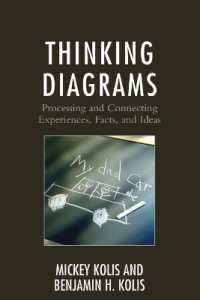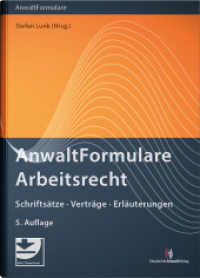- ホーム
- > 洋書
- > ドイツ書
- > Mathematics, Sciences & Technology
- > Earth Science
Full Description
This open access book on climate change assesses past climatic change from a geoscience perspective and directly and effectively addresses common misconceptions on climate and climate change.
A geoscience perspective on the multiple causes, rates, and consequences of climate change is essential context to assess modern climate change and our role in it, as well as forecasting future climate conditions. Yet, most textbooks on climate change focus only on the very recent past (e.g., last century), are not sufficiently engaging for non-scientists, or explore paleoclimate science at a level too challenging for introductory students. In addition, a wide range of misconceptions and confusion exists in the general public about climate change. Correcting misconceptions is an essential aspect of education, but educational research has shown that it is challenging to achieve. This textbook includes introductions to each thematic Part, that directly identify relevant misconceptions and refute them with clear, concise messages (i.e., learning goals) that are grounded in science and expanded on in the supporting chapters. Such refutation-style approaches have been shown to be effective at addressing misconceptions.
The book offers a clear trajectory of fundamental climate science concepts, which are most beneficially combined to provide a valuable geoscience perspective on the causes, rates, and consequences of climate change. It frames the collection of climate science chapters with impactful, relevant social science context: starting the book with a chapter that explores the reasons behind the disconnect between the scientific and public understanding of climate change, and ending the book with a discussion of the intersection of ethics and climate change. Short topical expansions or excursions are included as "boxes" within selected chapters.
This book will serve as a basic resource for learning about the lessons that the paleoclimate record offers to evaluate the seriousness of modern and future climate change.
Contents
Part I: Why is there a disconnect between the public perception and the scientific understanding of climate change?.- Chapter 1 What is the public understanding of climate change and how does this compare to the scientific understanding? Why is there a disconnect with the scientific understanding? How does taking a paleoclimate perspective help?.- Part II Why does the climate system involve more than the atmosphere?.- Chapter 2 What are the parts of the climate system and how do they interact?.- Part III I wasn't there, so how can I know about climate of the past?.- Chapter 3 How is historical climate data collected and calibrated?.- Chapter 4 How do we read the clues about past climate in ice?.- Part IV Temperature and CO2 have never been higher than today, right?.- Chapter 6 How does plate tectonics help drive long-term climate change.- Chapter 7 How does weathering help drive long-term climate change?.- Part V It's all just a cycle, right?.- Chapter 8What are climate cycles and what causes them? Where do we fit in a cycle?.- Part VI Because it was warmer in the past, we can't be the cause of global warming now, right?.- Chapter 9 Timescales, rates and tipping points: what were the causes and consequences of an abrupt global warming event of the past? How does this inform our understanding of climate change today?.- Chapter 10 How do climate models work? Does and increase in global average temperature mean it is warming everywhere? how is climate projected to change in the future?.- Part VII Because it was warmer in the past, we don't need to take action on global warming now, right?.- Chapter 11 Is this fixable? Geoengineering considerations.- Chapter 12 Going beyond the science: How do climate change and ethics intersect?.








